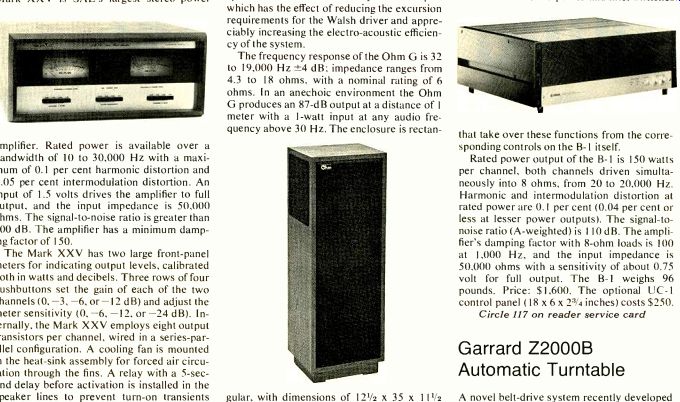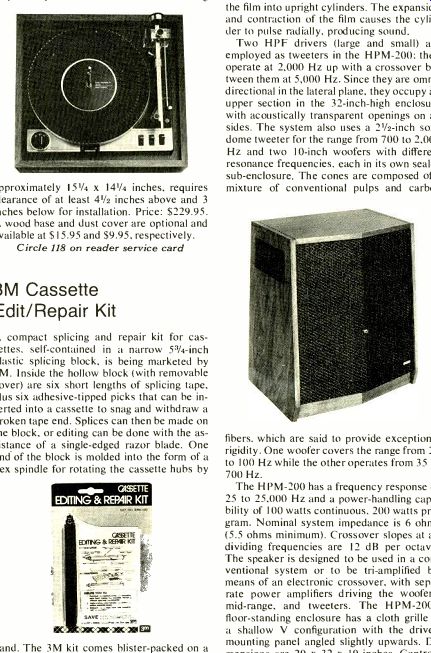SAE Mark XXV Stereo Power Amplifier
At 300 watts per channel continuous into 8-ohm loads, both channels driven, the model Mark XXV is SAE's largest stereo power amplifier. Rated power is available over a bandwidth of 10 to 30,000 Hz with a maxi mum of 0.1 percent harmonic distortion and 0.05 percent intermodulation distortion. An input of 1.5 volts drives the amplifier to full output, and the input impedance is 50,000 ohms. The signal-to-noise ratio is greater than 100 dB. The amplifier has a minimum damping factor of 150.

The Mark XXV has two large front-panel meters for indicating output levels, calibrated both in watts and decibels. Three rows of four pushbuttons set the gain of each of the two channels (0,-3,-6, or-12 dB) and adjust the meter sensitivity (0,-6,-12, or-24 dB). Internally, the Mark XXV employs eight output transistors per channel, wired in a series-parallel configuration. A cooling fan is mounted in the heat-sink assembly for forced air circulation through the fins. A relay with a 5-sec ond delay before activation is installed in the speaker lines to prevent turn-on transients from reaching the speakers. The amplifier is available in both consumer (Mark XXV, shown) and professional (Mark 2500) ver sions, the latter with rack-mounting slots and black face plate and handles. Price: $1,250. A wood cabinet is $44 extra.
Ohm G Speaker System
The new Model G speaker system from Ohm Acoustics has what is called an "abbreviated" Walsh driver measuring just 8 inches in diameter aryl 9 inches in height, as compared with the 12 x 16-inch dimensions of the Ohm F driver. As in the Model F, the driver operates according to the "wave-transmission-line" principle. Voice-coil impulses travel down ward through the inverted cone as concentric ripples; their velocity in the cone material and the included angle of the cone are so related to the velocity of sound in air that a phase-coherent acoustic waveform is generated. Radiation of the driver is omnidirectional in the horizontal plane, and the Ohm G enclosure has grille-covered openings on all four upper sides to permit this.
The Ohm G differs from previous Walsh designs in its low-frequency propagation. In stead of a sealed cabinet, the Ohm G em ploys a 1.05-cubic-foot enclosure with a 10-inch passive radiator. In normal installation the passive cone faces the rear wall; it has significant output only at 64 Hz and below. At lower frequencies the passive radiator is responsible for most of the system's output, which has the effect of reducing the excursion requirements for the Walsh driver and appreciably increasing the electro-acoustic efficiency of the system.
The frequency response of the Ohm G is 32 to 19,000 Hz ±4 dB; impedance ranges from 4.3 to 18 ohms, with a nominal rating of 6 ohms. In an anechoic environment the Ohm G produces an 87-dB output at a distance of 1 meter with a 1-watt input at any audio frequency above 30 Hz. The enclosure is rectangular, with dimensions of 12 1/2 x 35 x 11 1/2 inches. Optional finishes are oiled walnut veneer ($350) or walnut-grain vinyl ($300).
Yamaha Model B-1 Stereo Power Amplifier
Yamaha's new Model B-1 power amplifier is an all-FET (field-effect transistor) unit employing the newly developed vertical power FET's in output and driver stages. Benefits attributed to FET circuitry include high linearity with reduced generation of high-order distortion products within the amplifier, lower negative-feedback requirements with consequent improved electrical stability, and superior transient response and thermal stability.
The B-1 is constructed on a chassis measuring 18 x 6 x 11 1/2 inches, with completely separate power supplies for each channel. Parallel inputs permit either direct coupling from the preamplifier or the more conventional capacitive coupling. The amplifier also has a subsonic filter acting below 10 Hz with a slope of 12 dB per octave. Spring-loaded connectors for five pairs of speakers are pro vided, and these are intended to be switched by an optional control panel (the Model UC-1) which has controls, acting at the amplifier inputs, for matching the acoustic levels of the speakers. The UC-1 has connectors that plug directly into the front face of the B-1, or it can be used as a remote-control unit linked through an 18-foot cable that is supplied. Also incorporated in the UC-I are peak-reading meters for the two channels, calibrated in decibels and watts, and power and filter switches that take over these functions from the corresponding controls on the B-1 itself.

Rated power output of the B-1 is 150 watts per channel, both channels driven simultaneously into 8 ohms, from 20 to 20,000 Hz.
Harmonic and intermodulation distortion at rated power are 0.1 percent (0.04 percent or less at lesser power outputs). The signal-to noise ratio (A-weighted) is 110 dB. The amplifier's damping factor with 8-ohm loads is 100 at 1,000 Hz, and the input impedance is 50,000 ohms with a sensitivity of about 0.75 volt for full output. The B-1 weighs 96 pounds. Price: $1,600. The optional UC-1 control panel (18 x 6 x 23/4 inches) costs $250.
Garrard Z2000B Automatic Turntable
A novel belt-drive system recently developed by Garrard is one of the principal features of the new Garrard Z2000B automatic turntable. The belt is not turned directly by the motor pulley, but is instead driven by an inter mediate idler. This permits the use of a simple, mechanical speed-change and fine-tuning mechanism (a stepped, tapered motor shaft bearing on the idler) such as is found in many idler-driven automatic turntables.
The Z2000B is a two-speed (33 1/3 and 45 rpm) model with a built-in illuminated stroboscope to assist in adjusting its vernier Speed control at the two speeds. A stack of up to six discs is accommodated on its two-point sup port system, and a manual spindle that turns with the platter is included for single-play operation. The main controls of the turntable are three lever tabs to select manual or automatic operation, cue the tone arm (the cueing mechanism is damped in both directions of travel), and initiate and interrupt automatic play. The platter is an 111/2-inch nonferrous casting that weighs 5 pounds; it is driven by Garrard's familiar Synchro-Lab motor. An improved version of the Zero Tracking-Error tone arm is also used in the turntable. The magnetic anti-skating system is now calibrated for elliptical and CD-4 styli, and a resettable stylus timer has been added to indicate how many disc sides have been played (alerting the user to have his stylus examined at regular intervals). The rumble level of the Z2000B is-64 dB (DIN B weighting), and wow and flutter are 0.06 and 0.04 percent, respectively. The motorboard, measuring approximately 15 1/4 x 14 1/4 inches, requires clearance of at least 02 inches above and 3 inches below for installation. Price: $229.95. A wood base and dust cover are optional and available at $15.95 and $9.95, respectively.
3M Cassette Edit/Repair Kit
A compact splicing and repair kit for cassettes, self-contained in a narrow 53/4-inch plastic splicing block, is being marketed by 3M. Inside the hollow block (with removable cover) are six short lengths of splicing tape, plus six adhesive-tipped picks that can be inserted into a cassette to snag and withdraw a broken tape end. Splices can then be made on the block, or editing can be done with the assistance of a single-edged razor blade. One end of the block is molded into the form of a hex spindle for rotating the cassette hubs by hand. The 3M kit comes blister-packed on a cardboard sheet with complete illustrated instructions included. Price: $3.10.
Pioneer HPM-200 Speaker System
The high-polymer film electro-acoustic transducer developed by Pioneer and first used in a stereo headset has now found application in a new speaker system, the Model HPM-200.
The high-polymer material exhibits a piezo electric effect when an a.c. voltage is applied, expanding and contracting in the plane of the film's surface. Pioneer has formed sheets of the film into upright cylinders. The expansion and contraction of the film causes the cylinder to pulse radially, producing sound.
Two HPF drivers (large and small) are employed as tweeters in the HPM-200: they operate at 2,000 Hz up with a crossover be tween them at 5,000 Hz. Since they are omni directional in the lateral plane, they occupy an upper section in the 32-inch-high enclosure with acoustically transparent openings on all sides. The system also uses a 2 1/2-inch soft-dome tweeter for the range from 700 to 2,000 Hz and two 10-inch woofers with different resonance frequencies, each in its own sealed sub-enclosure. The cones are composed of a mixture of conventional pulps and carbon fibers, which are said to provide exceptional rigidity. One woofer covers the range from 25 to 100 Hz while the other operates from 35 to 700 Hz.
The H PM-200 has a frequency response of 25 to 25,000 Hz and a power-handling capa bility of 100 watts continuous, 200 watts pro gram. Nominal system impedance is 6 ohms (5.5 ohms minimum). Crossover slopes at all dividing frequencies are 12 dB per octave.
The speaker is designed to be used in a conventional system or to be tri-amplified by means of an electronic crossover, with separate power amplifiers driving the woofers, mid-range, and tweeters. The HPM-200's floor-standing enclosure has a cloth grille in a shallow V configuration with the driver-mounting panel angled slightly upwards. Dimensions are 29 x 32 x 19 inches. Controls on the system adjust the outputs of the HPF tweeters separately over a±3-dB range in five steps and the mid-range output over a ±1.5-dB range in three steps. Price: $500.
PUBLISHER'S NOTICE: Recent fluctuations in the value of the dollar will have an effect on the price of merchandise imported into this country. So, please be aware that the prices quoted in this issue may be subject to change.
---
TURNTABLE BASICS: A little preliminary homework will make you a lot smarter in the market